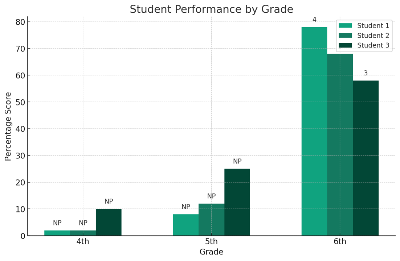Did you know?
Learning-Focused began providing professional development on Acceleration in 2003.
"All the wonderful ideas will be used immediately to help our struggling students be successful."
- Lisa Neld, TN
For more than three decades, the predominant approach in schools and districts has been to address and close learning gaps solely through remediation and re-teaching. Regrettably, this exclusive focus has consistently fallen short in propelling the majority of students to reach grade level proficiency. If it were effective, we would observe greater academic growth in 8th-grade students compared to their 4th-grade counterparts, as indicated by the National Assessment of Educational Progress (NAEP).
While an increasing number of educators now recognize the critical need to shift towards Acceleration rather than Remediation, there persists a host of misunderstandings surrounding what Accelerated Learning entails and how to systematically plan and implement it consistently and comprehensively.
Like many educational initiatives, the goal is to make the implementation of evidence-based interventions like Accelerating, or Accelerated Learning, as easy as possible. This has led to common misconceptions about the most effective ways of maximizing impact within a school, including:
Misconception 1: Acceleration Lowers Grade Level Learning Expectations
Clarification: Accelerated Learning, contrary to the misconception, does not lower grade-level expectations. Instead, it involves employing various strategies to effectively support and challenge students, ensuring their progression towards meeting or exceeding grade-level standards.
Misconception 2: Acceleration is a Single Practice
Clarification: Accelerated Learning encompasses multiple strategies and practices that differentiate learning, supporting and challenging students before, during, and after each lesson. It goes beyond a singular practice, providing a comprehensive approach to individual achievement.
Misconception 3: Acceleration Replaces Remediation
Clarification: While Acceleration is a shift in focus, it doesn't replace remediation; rather, it incorporates it as one of the practices. The key distinction lies in the amount of time allocated to remediation, with the goal of reducing it as more Accelerated Learning practices are implemented.
Misconception 4: Acceleration Occurs Outside Core Instruction
Clarification: Acceleration is most effective when implemented school-wide, involving every teacher in supporting students. While there is often a focus on intervention teachers, the reality is that each teacher plays a significant role in the success of Accelerated Learning, supporting core instruction.
Misconception 5: Acceleration is Simple to Implement
Clarification: Implementing Accelerated Learning requires proactive planning and collaboration. Its success hinges on advance preparation, including specific supports utilized before, during, and after lessons. The complexity of implementing Accelerated Learning is a key reason why Remediation alone persists as the primary intervention, as technology makes it easier to carve out time on a computer. However, the investment in Accelerated Learning yields more comprehensive and sustainable results.

Accelerating Learning allows educators to address the learning needs of students by enabling them to identify potential learning gaps or struggle points early on. This early intervention is critical to preventing students from falling behind and struggling to catch up later.
"All the wonderful ideas will be used immediately to help our struggling students be successful."
- Lisa Neld, TN


Catawba County Schools is a school district in North Carolina. Like many districts, they knew some students struggled to meet proficiency levels, particularly in mathematics. Traditional remediation methods were not yielding the desired results, and there was a need for an innovative approach to address performance and boost student confidence.


Exemplary Schools distinguish themselves by directing support precisely where students require success—the grade-level classroom lesson. By integrating all support programs into a cohesive focus, they ensure a united and seamless learning experience that is not fragmented or tethered to expectations below grade level.
In Exemplary Schools, Acceleration strategies permeate the entire educational landscape, aiming to:
In the complex landscape of education, where balancing the demands of curriculum, instruction and assessment requires capacity and sustainability, implementing Acceleration can pose considerable challenges, including:
Teachers often face time constraints due to a packed curriculum and other responsibilities. Planning for acceleration and addressing struggle points requires additional time for analysis, individualized planning, and implementation.
Managing a classroom with diverse learning needs can be challenging. Teachers need to adapt their instruction to accommodate varying readiness levels and learning preferences, which requires careful planning and flexibility.
Some teachers may have limited access to resources, such as additional materials, technology tools, or professional development opportunities. Lack of resources can hinder the effective implementation of acceleration practices.
Not all teachers may have received adequate training in implementing acceleration practices or addressing struggle points. Professional development opportunities may be limited, making it difficult for educators to acquire the necessary skills and knowledge.
Some teachers may be resistant to change or may have established teaching methods that they are comfortable with. Implementing new practices and addressing struggle points may require a shift in teaching philosophy, which can be challenging for some educators.
Accurately assessing students' readiness levels and identifying specific struggle points can be challenging. Teachers need reliable assessment tools and methods to gather meaningful data for effective planning.
In light of these challenges, Learning-Focused partners with schools and districts to offer strategic solutions and collaborative approaches. We focus on addressing these hurdles proactively, by providing quality resources and professional development, and ensuring the successful integration of Acceleration through a shared responsibility of implementation, for both administrators and teachers.